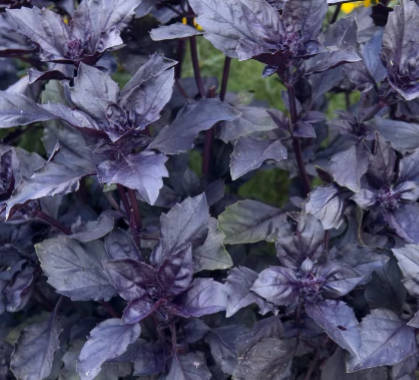If you love eating basil all year round and want a beautiful edible plant that will bring the bees to your garden then without a doubt you have to get your hands on this beauty.
This perennial herb (for us warm climate dwellers) is a hybrid of two different species Ocimum kilimandscharicum (camphor basil) and Ocimum basilicum (dark opal). Due to this hybrid status, you can leave the flowers and you don't have to worry about it going to seed and dying, although giving it a good trim back will make it very lush and bushy.
View this post on InstagramLove this African blue basil 😍😍😍
A post shared by Nicki Murray (@loveofdirt) on
The leaves start out as a beautiful purple and as the plant gets older the leaves turn green. It has stunning purple flowers which are like bee tractor beams, my plants always have a swarm of bees getting the goodness out of those purple flowers. It also makes a beautiful cut flower for inside if you are so inclined.
View this post on InstagramA post shared by Nicki Murray (@loveofdirt) on
The taste
The flavour of the african blue basil I find is earthy and less aniseed like other perennial basils, so I use it as I would a sweet basil. It makes a beautiful pesto, and is also great in bruschetta.
Growing space
If you're going to grow this one in a pot, pick the biggest one you can get. It can get quite big, my original plant which I harvest from quite regularly has taken over a 1m square garden bed. It did successfully grow in a 20cm pot before moving it to this bed, but you can really tell it let it's roots spread when it was given the space.
Location
It loves sunshine and good draining soil, so choose a spot that is going to get plenty of it. We have clay soil, and it seems to do well directly in the garden, but I've heard of it turning up it's toes if it's always got wet feet. So like most things, lots of sunshine and well draining soil.
View this post on InstagramA post shared by Nicki Murray (@loveofdirt) on
Care
To keep your plant lovely thick and lush it can deal with a good prune every now and then (and if you love basil that's easy to do). I honestly don't give it much in the way of anything else, but making sure your soil is in tip top shape is going to do wonders.
Propagation
Sadly because it's a hybrid species you can't save the seeds. It is however one of the easiest herbs I have ever propagated, and I found out by mistake when I cut some of the flowers to put in a vase inside, within a week the cutting had enough roots to directly plant out.
View this post on InstagramKitchen windowsill propagation station
A post shared by Nicki Murray (@loveofdirt) on
Have you got an african blue basil? What's your favourite basil?








